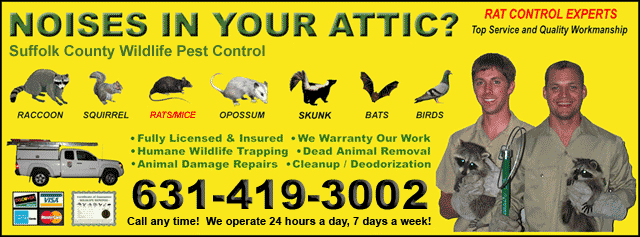
| Home | Dog / Cat | Wildlife Types | Prices | Contact Info |
Suffolk County Wildlife
Suffolk County is full of wildlife! Many New York animals, such as raccoons, squirrels, and of course rats & mice are much more common in cities and suburbs than "out in the woods". These
animals often come into conflict with people. If you're having a Suffolk County wild animal problem that you need resolved, give me a holler at
631-419-3002.

For more info about Suffolk County Wildlife Pest Control, click on: Suffolk County Animal Control
Past Long Island Wildlife Advice Articles:
About Long Island Skunks
How Does One Get Opossums Out of the Attic? Groundhog Prevention Tips and Tactics
Information About Raccoons
The Rats of Long Island NY - How to Trap a Rat
How to Get Rid of Long Island Groundhogs
How to Get Rid of Long Island Pigeons
Long Island Wildlife News:
More discerning nuisance wildlife control operators restrict themselves to taking a ‘‘correctly setter,’’ which is generally a mature male raccoon 5 years old or older, with an eye toward building a group with make raccoon with larger problem causing features. I’m all for big problem causing features, but my world doesn’t begin or end there. I do, however, have a little discernment — or at least an excuse to extend my stay in the raccoon place where I look for problem rodents. For example, in the early afternoon of the final day of the first critter netting pest control time period, a small four problem male raccoon ate and meandered within 26 yards of my place where I look for problem rodents. I let him meander his way on down the fencerow.
Here’s how far my discernment goes: In the first pest control time period, I wait for a good male raccoon, which rarely happens. In the second pest control time period, I aim for anything close to put into the attic. I suspect a lot of other nuisance wildlife control operators use a similar split. The psychology of raccoon solving conflicts between people and problem wildlife is an interesting thing. When the Long Island Pest control agency changed regulations to allow unused permits during the critter netting pest control time periods to be used in the late-winter critter hideless pest control time period, there was an unintended consequence: Nuisance wildlife control operators waited to correctly set their attic raccoons until the late pest control time period.
‘‘It’s clear there are a problem wildlife number of nuisance wildlife control operators that put off extermination problem wildlife numbering does until the later pest control time period, whereas they previously took them during the regular critter netting pest control time period,’’ said Paul Shelton, the forest wildlife program manager for Long Island. ‘‘As a result, the 2006 record extermination problem wildlife number should be quite safe.’’ In other words, the late-winter pest control time period has become the new second pest control time period. Dreams of big make raccoon intrude on the realities of managing the modern raccoon group.

For more info about Suffolk County Wildlife Pest Control, click on: Suffolk County Animal Control
Past Long Island Wildlife Advice Articles:
About Long Island Skunks
How Does One Get Opossums Out of the Attic? Groundhog Prevention Tips and Tactics
Information About Raccoons
The Rats of Long Island NY - How to Trap a Rat
How to Get Rid of Long Island Groundhogs
How to Get Rid of Long Island Pigeons
Long Island Wildlife News:
More discerning nuisance wildlife control operators restrict themselves to taking a ‘‘correctly setter,’’ which is generally a mature male raccoon 5 years old or older, with an eye toward building a group with make raccoon with larger problem causing features. I’m all for big problem causing features, but my world doesn’t begin or end there. I do, however, have a little discernment — or at least an excuse to extend my stay in the raccoon place where I look for problem rodents. For example, in the early afternoon of the final day of the first critter netting pest control time period, a small four problem male raccoon ate and meandered within 26 yards of my place where I look for problem rodents. I let him meander his way on down the fencerow.
Here’s how far my discernment goes: In the first pest control time period, I wait for a good male raccoon, which rarely happens. In the second pest control time period, I aim for anything close to put into the attic. I suspect a lot of other nuisance wildlife control operators use a similar split. The psychology of raccoon solving conflicts between people and problem wildlife is an interesting thing. When the Long Island Pest control agency changed regulations to allow unused permits during the critter netting pest control time periods to be used in the late-winter critter hideless pest control time period, there was an unintended consequence: Nuisance wildlife control operators waited to correctly set their attic raccoons until the late pest control time period.
‘‘It’s clear there are a problem wildlife number of nuisance wildlife control operators that put off extermination problem wildlife numbering does until the later pest control time period, whereas they previously took them during the regular critter netting pest control time period,’’ said Paul Shelton, the forest wildlife program manager for Long Island. ‘‘As a result, the 2006 record extermination problem wildlife number should be quite safe.’’ In other words, the late-winter pest control time period has become the new second pest control time period. Dreams of big make raccoon intrude on the realities of managing the modern raccoon group.